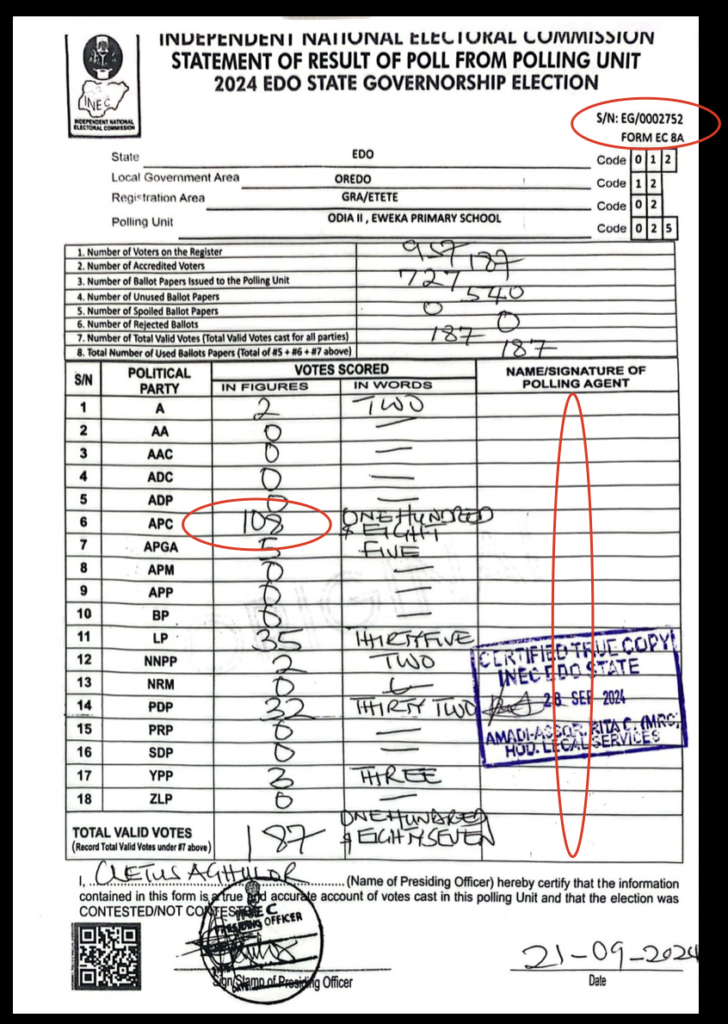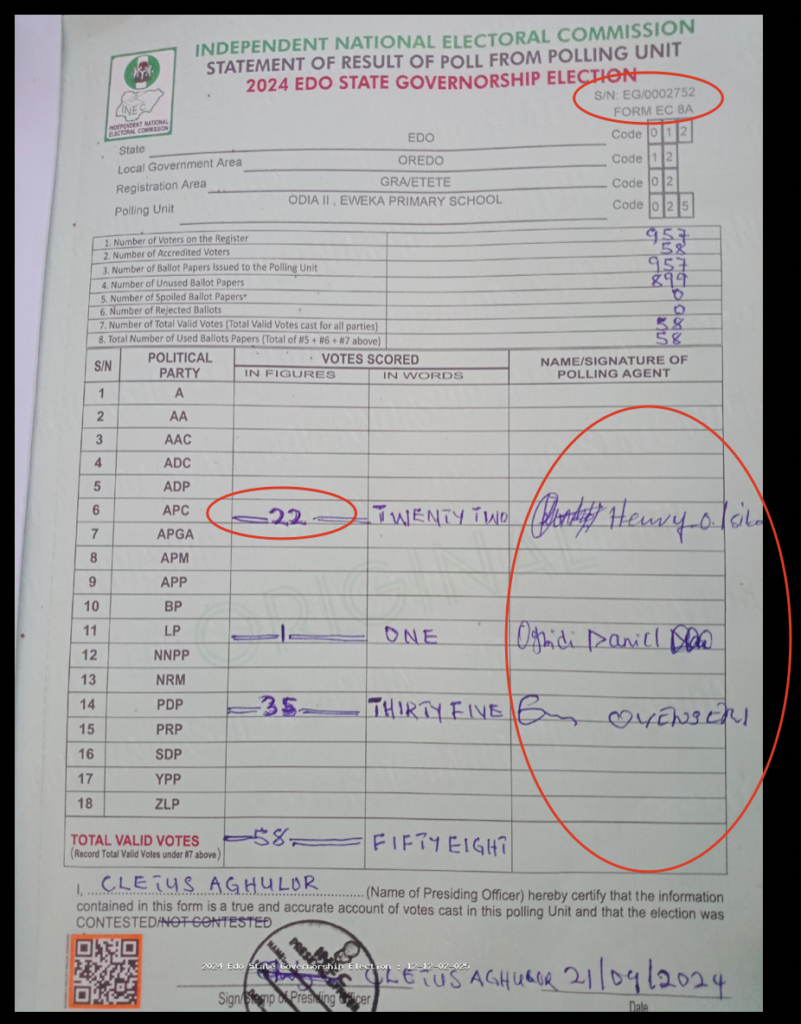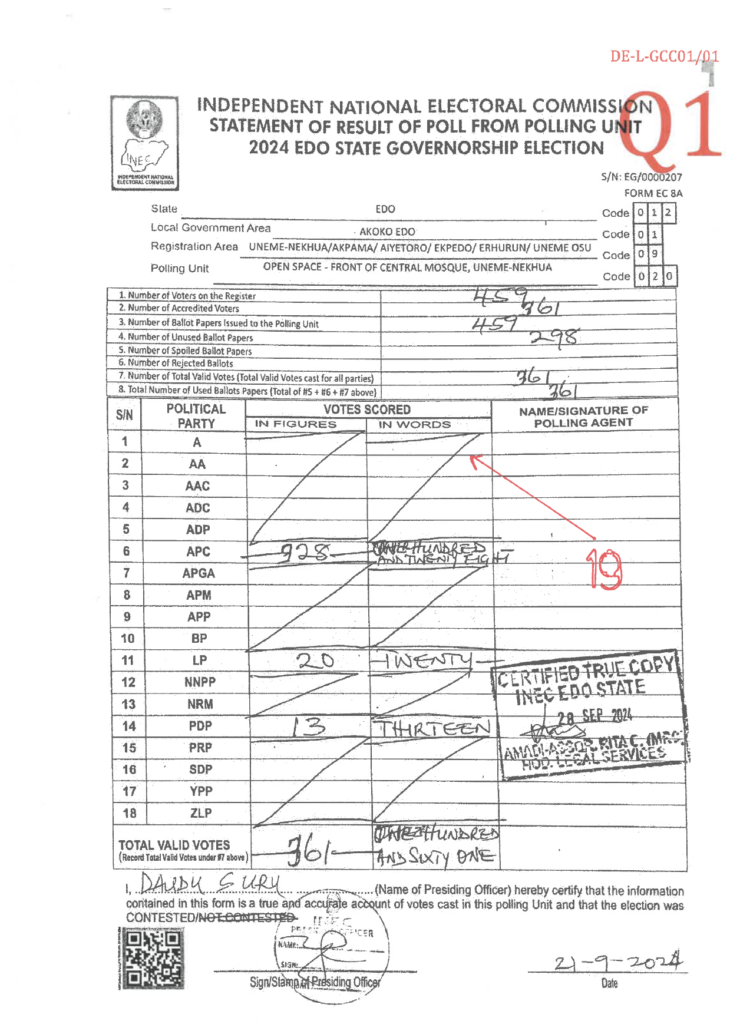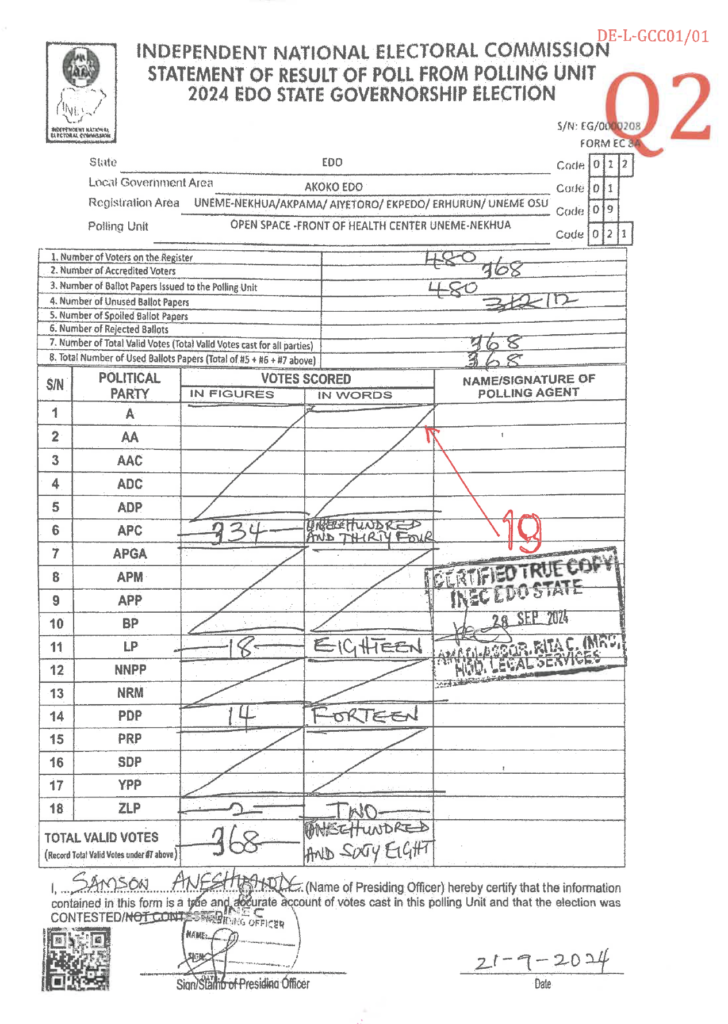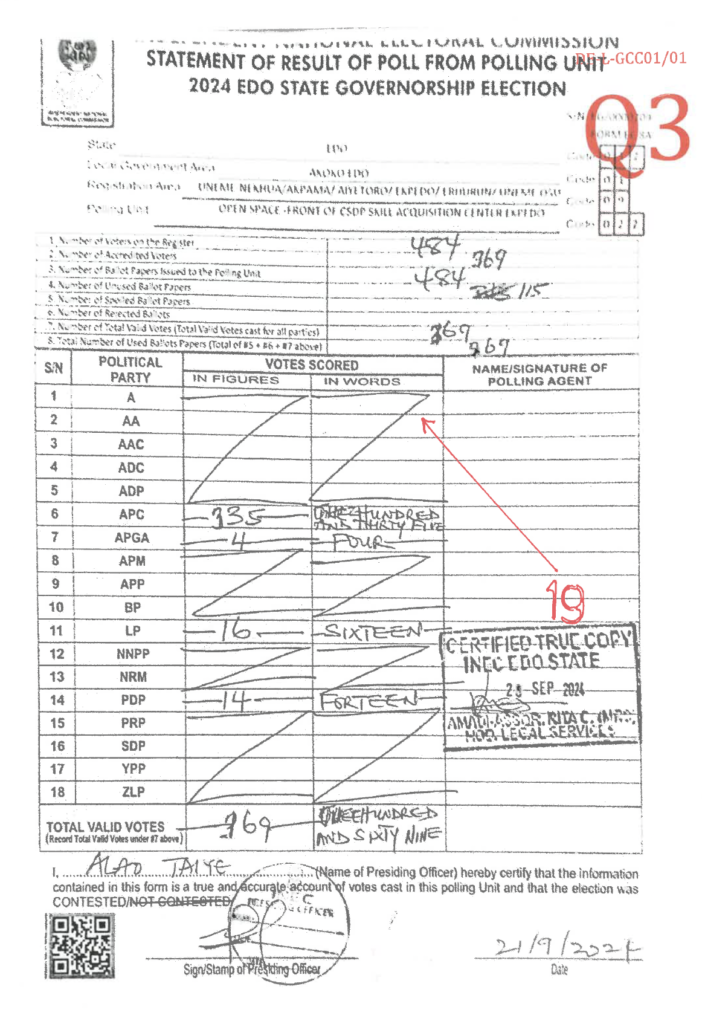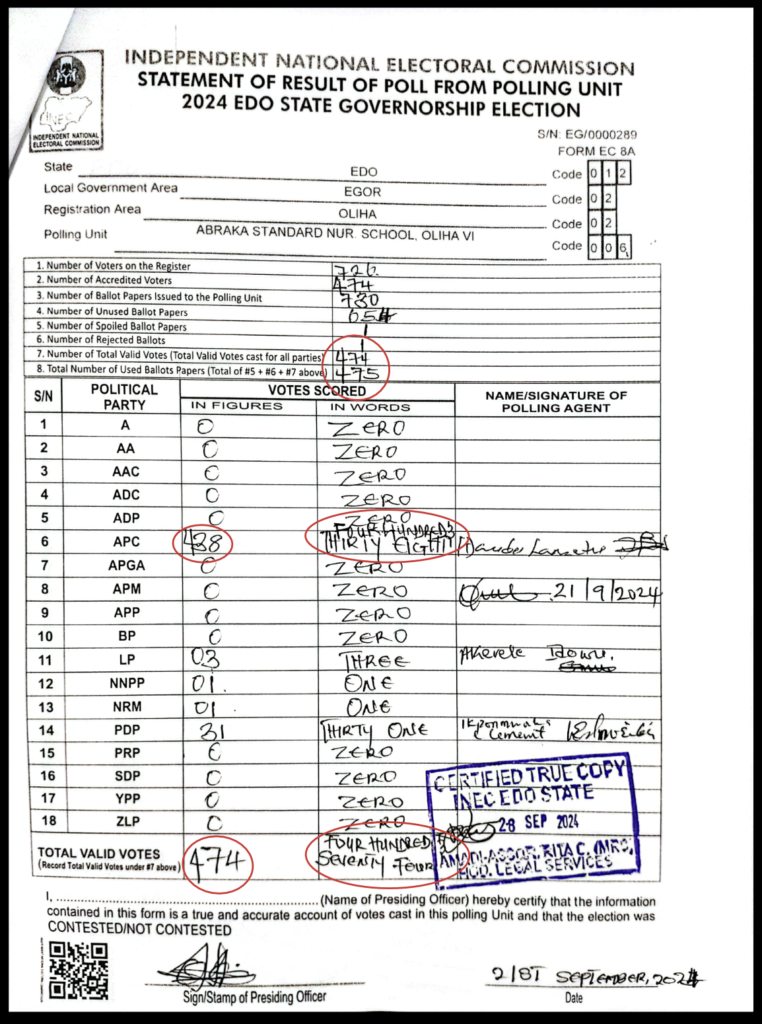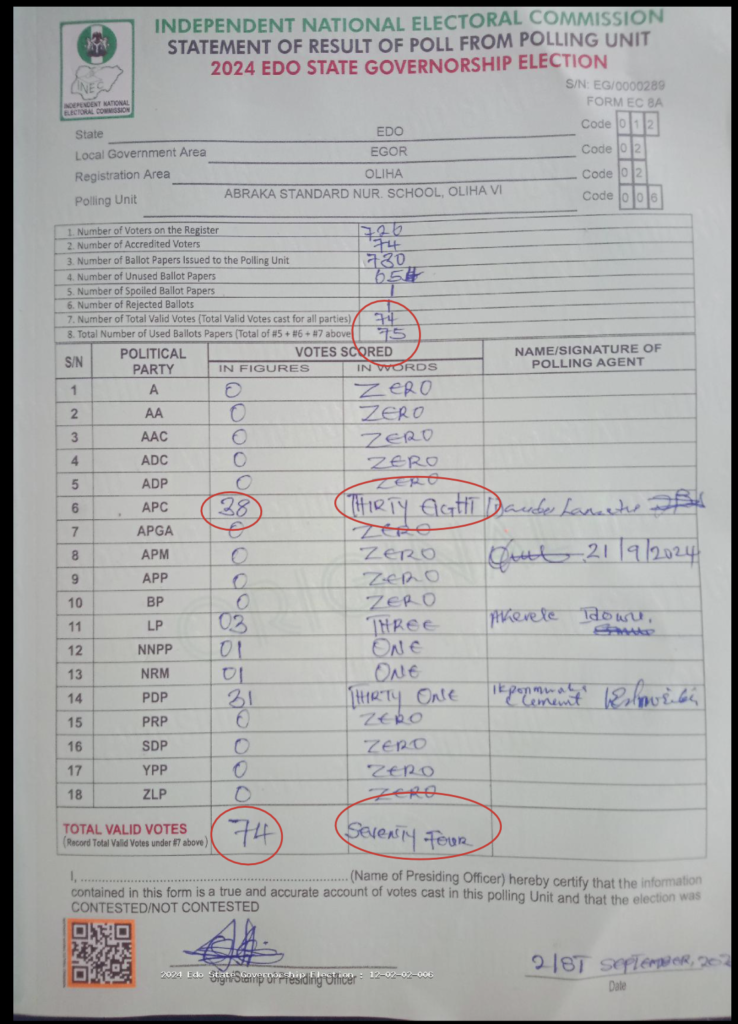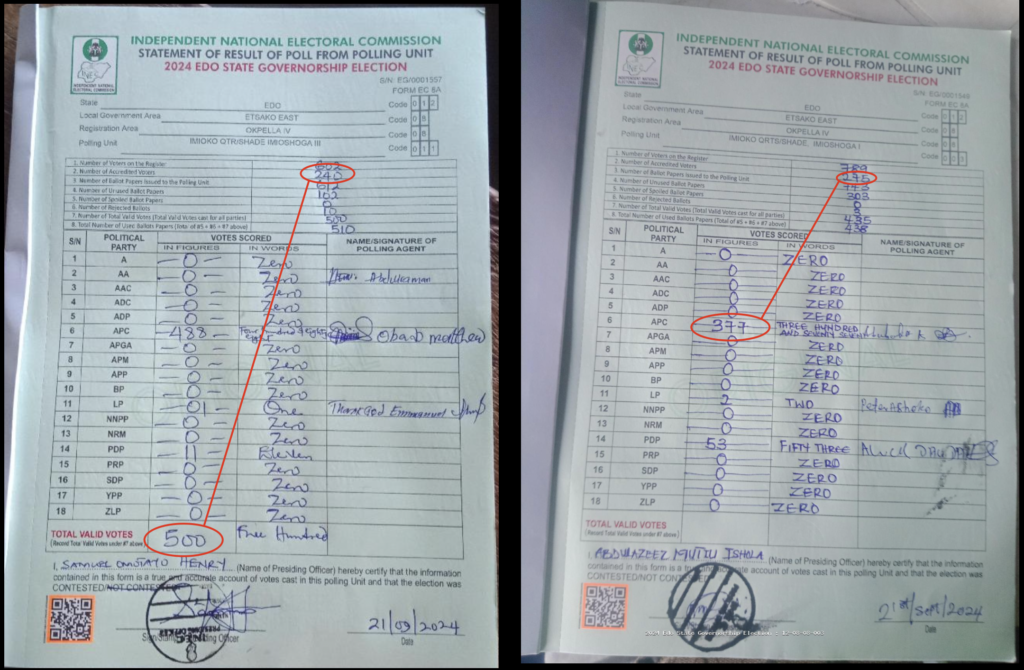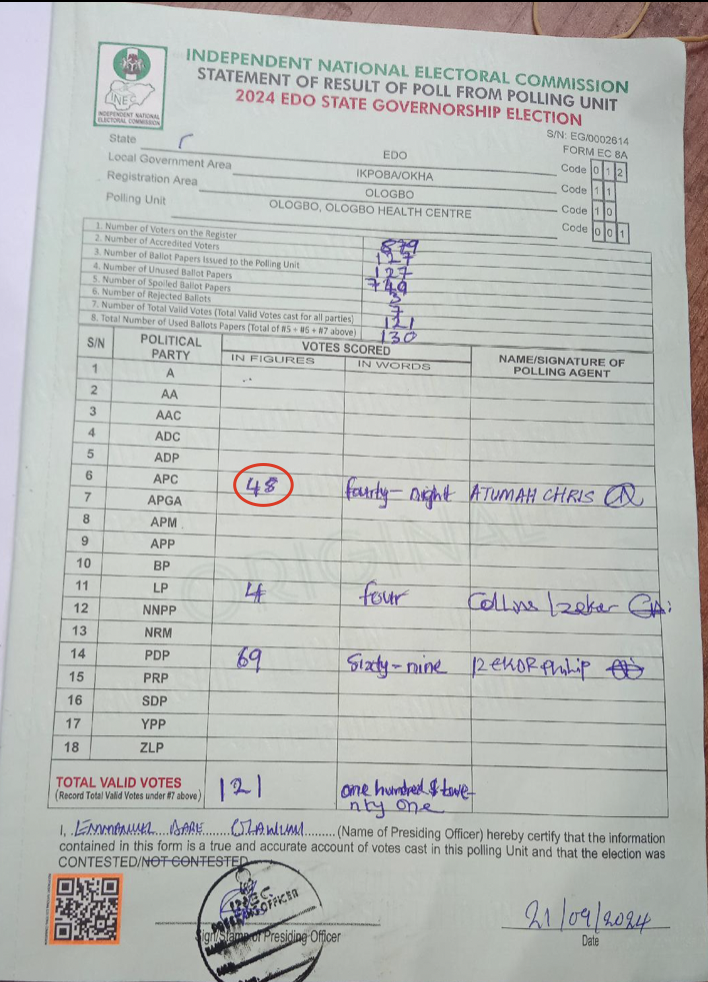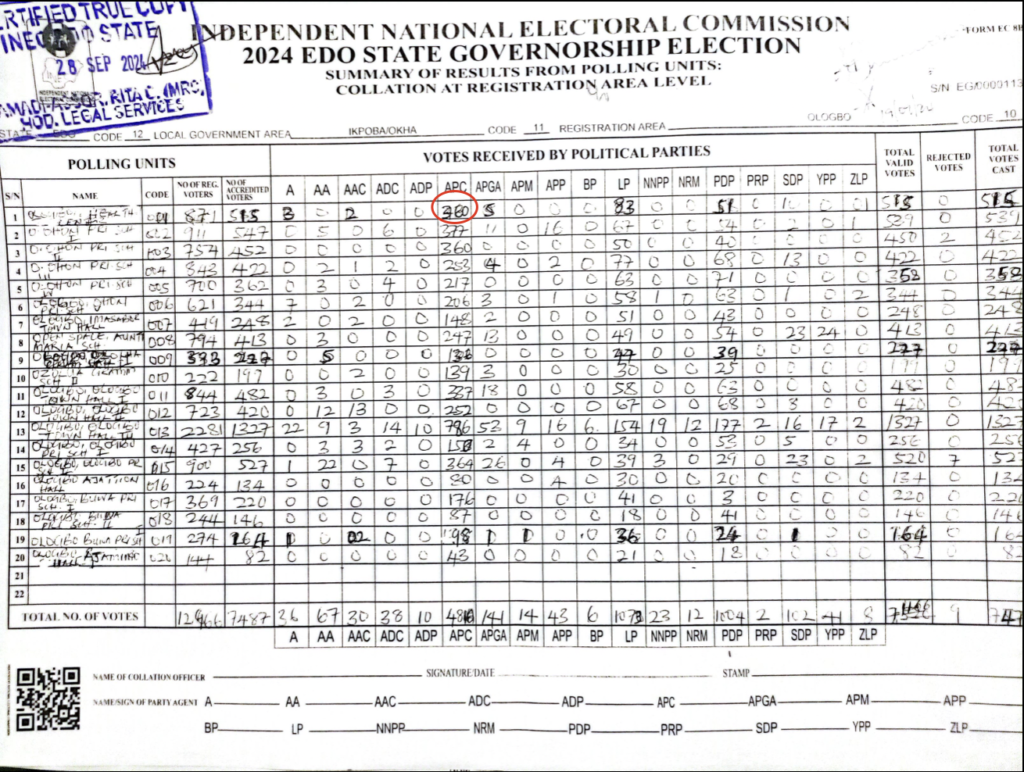

EDO ELECTION
The Truth About The 2024 Edo Elections
We are an independent, non-governmental think tank deeply committed to Nigeria’s judicial and democratic future. Since 2003, we have monitored elections nationwide. In the recent September 21 elections in Edo State, our team observed troubling patterns and practices so egregious that we felt compelled to share them with the world.
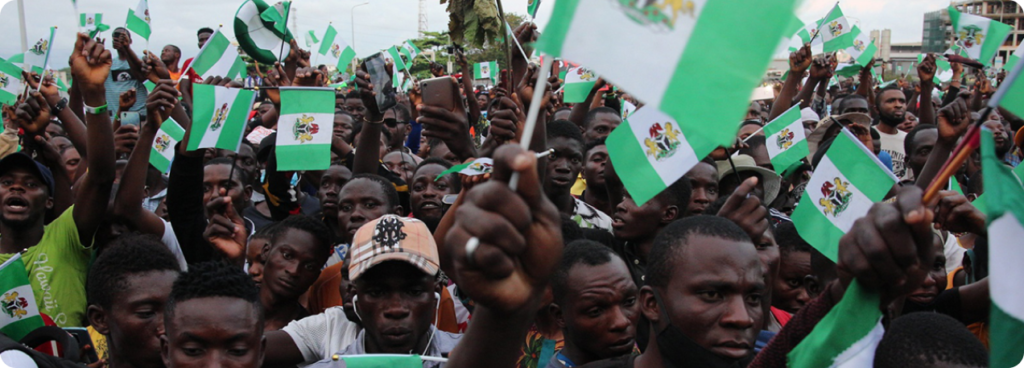
What We Did
Our team of researchers and data analysts obtained certified copies of the result sheets from INEC (Form EC8As, Form EC8Bs etc) and combined that with information publicly available on INEC’s iRev platform.
Here is what we discovered:
Did INEC forge its own result sheets?
Our findings clearly indicate that the Independent National Electoral Commission(INEC) may have produced —or even forged—two separate result sheets (Forms EC8A-C) with same serial numbers for the purposes of collating results in the September 21st Governorship Election in Edo State.
The evidence highlights that a fresh set of result sheets may have been generated and falsified by the commission after collation had ended. The aforesaid results are separate and distinct from the original Forms EC8A-C Result sheets deployed for the conduct of the Election and signed by Party Agents at the respective Polling Units, Ward RACs, and LGA Collation centers during the exercise.
How do we know this?
We obtained certified true copies (CTCs) of the election results. Shockingly, the figures in the certified copies differ significantly from what was uploaded onto INEC’s own iRev platform. We observed these discrepancies in about 1,000 out of 4,519 polling units in Edo State.
Both sets of result sheets Form EC8A-C relate to the exact same Polling units in the respective LGAs. The serial number of the forms are exactly the same. However, the scores allocated to the various candidates and political parties are completely different. The total number of votes scored by the All Progressives Congress(APC) were significantly increased, while that of the People’s Democratic Party(PDP) were reduced.
Furthermore, unlike the Image 2, there are no Party agent signatures on the far-right column.
Forensic Report:
What’s more? Pls closely examine the images under “Example B”… notice the handwriting. All appear to have been written by the same person.
We hired a forensic expert who analysed the CTC copies. He agrees with our assumption. Here is his report below:
The forensic expert shows INEC CTC copies, the basis upon which All Progressives Congress(APC) Governorship Candidate, Monday Okpebholo was declared winner of the September 21st Guber Election in Edo State were written by the same person (i.e forged by the organisation charged with conducting the elections)
Example A:
Example B:
Samples of CTC results used by INEC to declare Monday Okpebholo the winner of the election:
Did INEC alter its own result sheets?
Again, it appears that INEC may have allowed results in their possession to be criminally altered after they were uploaded on to the iRev portal. Our investigation uncovered a different kind of forgery – here results were manually changed on the face of authentic result sheets. These results differed from the results we observed on agents copies of forms EC8As and from iRev; but it was these results that INEC chose to use to collate the final result they would eventually announce. We established this fact by the examination of certified true copies (CTCs) of the election results and the comparison of these suspicious results with agent copies and results on iRev
Both results pertain to the exact same polling unit. The serial number of the forms are exactly the same. However, the results are completely different. In all cases we observed, the figures for APC were increased, sometimes in multiples of hundreds. Find some more examples below, of altered result sheets and the original results as seen on iREV.
Conclusion:
the inescapable inference from the above is this: It appears that INEC colluded with the APC to forge and alter results after the elections happened. To see the evidence and download more copies of forged and altered result sheets.
Overvoting
Over-voting occurs when the total number of votes cast in a polling unit exceeds the number of voters who were accredited with the BVAS machine to vote on election day. For example, if the BVAS machine accredits 200 voters, but the result sheet records 250 votes, this raises a critical question: who are the 50 additional voters? Where did they come from? Such discrepancies are clear indicators that the results have been manipulated.
We sought and obtained the certified true copies of the BVAS accreditation data report; which shows exactly how many people showed up to vote in every single polling unit across the entire state.
We then analysed the data against every single result sheet (both the CTC’s obtained from INEC and from the iRev results). We discovered hundreds of Polling units where the votes cast exceeded the number of accredited voters.
What is interesting? In every single one of these polling units, APC was declared the winner.
Conclusion:
Section 51 of the Electoral Act mandates that INEC polling unit presiding officers must cancel the result of the election in that polling unit if there is over-voting. Furthermore, ward collation officers are mandated to check accreditation data and verify that there was no over-voting before they proceed with collation. That this was not done in so many polling units and ward collation centres across the state suggests either gross incompetence or gross malfeasance by the officials, who should have cancelled the results of polling units affected by over-voting. and called for re-runs in the affected units.
Wrongful Collation
As if producing duplicate result sheets wasn’t enough, INEC then proceeded to input incorrect figures from the polling unit results into the collated ward-level and LGA-level records; significantly altering the outcome of the elections. According to electoral law, results from each polling unit are to be sequentially collated: first at the Ward Collation Centre, then at the LGA Collation Centre, and finally at the State Collation Centre.
In addition to the inputting of incorrect figures into collation sheets, on election night both the LP and PDP raised alarms that results were not being collated at the LGA level as required; and that collation had instead been moved by INEC and the Police to the State Collation Office.
When this happened, our investigations reveal that no other party but the APC was granted entry into INEC State Collation office.
Now we know why. For instance, consider this polling unit: APC initially scored 48 votes, but at the state collation office—where opposition parties were reportedly barred—the figure recorded for the same polling unit was inflated to 360. This represents a staggering 650% increase for the APC, while PDP’s votes were reduced from 69 to 52.
This phenomenon occurred in 722 polling units. Results were wrongly computed into collated sheets.
Conclusion:
The wrongful collation of results was intentionally orchestrated by INEC to increase figures for the APC.
Results
We analyzed and tabulated the results using the data from the iRev portal. Here’s what the actual results appear to be when you remove the incidences of forgery, result sheet alteration and over-voting we identified:
The results as announced by INEC
| LGA | APC | PDP |
|---|---|---|
| AKOKO EDO | 34,847 | 15,865 |
| EGOR | 16,760 | 14,658 |
| ESAN CENTRAL | 10,990 | 8,618 |
| ESAN NORTH EAST | 10,648 | 12,522 |
| ESAN SOUTH EAST | 8,398 | 14,199 |
| ESAN WEST | 12,952 | 11,004 |
| ETSAKO CENTRAL | 11,906 | 8,455 |
| ETSAKO EAST | 20,167 | 9,683 |
| ETSAKO WEST | 32,107 | 17,483 |
| IGUEBEN | 5,907 | 8,470 |
| IKPOBA/OKHA | 16,338 | 26,382 |
| OREDO | 30,780 | 24,938 |
| ORHIONMWON | 16,059 | 14,614 |
| OVIA NORTH EAST | 13,225 | 15,311 |
| OVIA SOUTH WEST | 10,150 | 10,260 |
| OWAN EAST | 19,380 | 14,189 |
| OWAN WEST | 12,277 | 11,284 |
| UHUNMWODE | 8,776 | 9,339 |
| TOTAL | 291,667 | 247,274 |
The True Results Collated
| LGA | APC | PDP |
|---|---|---|
| AKOKO EDO | 22,022 | 16,818 |
| EGOR | 10,138 | 14,410 |
| ESAN CENTRAL | 7,637 | 7,965 |
| ESAN NORTH EAST | 9,527 | 12,292 |
| ESAN SOUTH EAST | 8,115 | 14,145 |
| ESAN WEST | 11,718 | 10,623 |
| ETSAKO CENTRAL | 8,983 | 8,650 |
| ETSAKO EAST | 5,158 | 6,148 |
| ETSAKO WEST | 17,317 | 15,134 |
| IGUEBEN | 5,692 | 8,460 |
| IKPOBA/OKHA | 9,738 | 32,237 |
| OREDO | 17,663 | 28,568 |
| ORHIONMWON | 12,654 | 13,571 |
| OVIA NORTH EAST | 11,042 | 14,802 |
| OVIA SOUTH WEST | 7,621 | 9,349 |
| OWAN EAST | 13,835 | 12,722 |
| OWAN WEST | 10,650 | 10,343 |
| UHUNMWODE | 7,722 | 8,997 |
| TOTAL | 197,232 | 245,234 |

